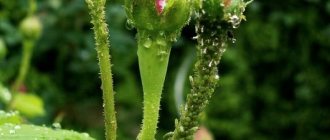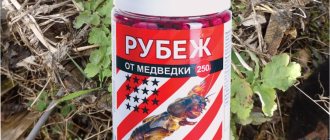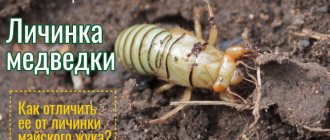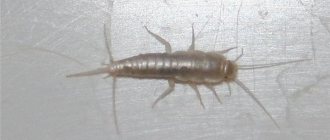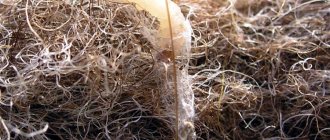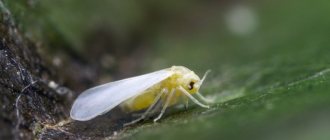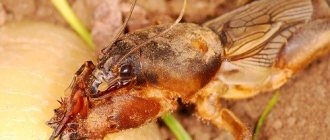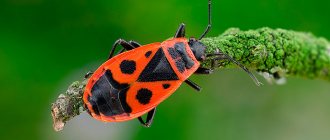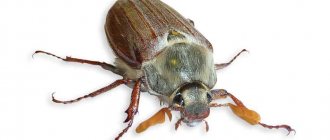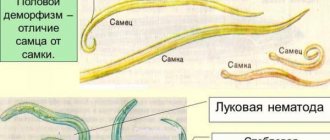Cucumbers are quite capricious to grow; they require optimal conditions in terms of parameters such as temperature, humidity, and the amount of microelements in the soil. In addition, they are susceptible to various diseases. The article outlines the main diseases of cucumbers in a greenhouse and their treatment, you will find out why the leaves turn pale and dry, the ovary disappears, how to understand that cucumbers have been attacked by aphids and spider mites, why cucumbers do not set. More often, gardeners encounter the following pests: Greenhouse whitefly - a small but voracious insect that can suck juice from leaves in a short time. As a result of its vital activity, a sooty fungus is formed and the plants die. Aphids are sucking pests that appear on cucumbers in July-August. It develops quickly, depletes plants, sucking out juices and spreading viral diseases. Aphid colonies can be found on the undersides of leaves.
Pests of cucumbers - description with photos
Table 1
| Name | Description |
Spider mite | This pest is ubiquitous, but gives greater preference to enclosed spaces. The appearance of a mite is indicated by the cobwebs woven by the insect on the growth shoots. A reddish-green small pest hiding on the underside of the leaf blade During a season, a female is capable of laying more than one and a half hundred eggs, giving birth to several generations. 2 weeks after laying, the larvae are able to completely dehydrate the plant by sucking out its juices The insect does not have a protective layer on its body, which makes it easier to combat it with chemicals |
melon aphid | The name of the insect is conditional - the pest is omnivorous. The glutton barely reaches 2 mm and has a green, oblong-rounded body. You can find a colony of aphids on the underside of the leaf, where they hide from the weather and their enemies. In favorable conditions, the queen can produce up to 2 dozen generations during the growing season. At the same time, the founder of the genus is wingless and remains in one place, and the offspring are settled by winged individuals Aphids are poisonous insects, so the plant can quickly die. In addition, the pest is a carrier of dangerous diseases. |
Whitefly | This small insect with a yellow body and mealy wings looks like a butterfly. The adult does not cause much harm to plants - the microscopic larvae that stick to the underside of the leaf are dangerous. The small pest cannot be detected immediately. Its presence can be guessed by the fading foliage and numerous holes on the plate The whitefly is also dangerous because it attracts sooty fungus spores to the plant. |
Sprout fly | This pest prefers seeds and young shoots. The average size of a fly is 3 mm, a newborn insect barely reaches 1 mm. It is this “trifle” that is a dangerous enemy for garden crops The insect's life cycle takes place in the soil. Therefore, the larvae, having mandibles instead of heads, eat everything that is there (including cucumber sprouts) |
Root nematode | The favorite place of the harmful worm is closed ground. It is difficult to detect the insect - the nematode settles in the roots of plants, forming galls on them. There are no signs of damage to the above-ground parts, but the plants lag behind in development and appear depressed in appearance To verify the presence of a pest, it is recommended to dig up one bush and carefully examine its roots. Having discovered growths, you will have to remove the remaining plants and disinfect the ground |
Tobacco thrips | Another small pest with wings barely reaches a millimeter in size. Externally, striped insects look like tadpoles, but they have legs, and thanks to them thrips move quickly Both larvae and adults cause damage, without missing a single area on the plant. The immune system of insects is resistant to any external influence, so it is difficult to fight them |
Black flea beetle | Outwardly, this small insect is somewhat similar to parasites that plague animals. They move very quickly, jumping from one leaf to another. The flea beetle is very dangerous for plants. By sucking juice and gnawing tissue, the insect can destroy cucumber seedlings in a couple of days |
Ants | These insects do not feed on cucumbers, but by digging through numerous tunnels in the ground, they gnaw out the roots of plants. Therefore, despite the benefits of ants (enrichment of the soil with humus and microelements, destruction of parasites), colonies that have arisen in cucumber beds will have to be fought |
Medvedka | The summer residents especially disliked this “robber”. Adults are quite large - at least 5 cm in length. They have short wings and powerful serrated legs, with which they actively dig numerous passages in the ground. In one clutch, the female is capable of laying about 400 eggs. In 3 weeks, the entire garden will be filled with an army of omnivorous larvae. They are dangerous both for seeds and seedlings, and for the fruiting plant. |
Slugs | Harmless at first glance, mollusks are the real scourge of garden crops. In essence, it is a “harvester” for eating greens. Slugs destroy plantations in the shortest possible time, quickly wielding their oral grater, consisting of 40 thousand teeth. |
If you simply poison pests with pesticides, after 2 years the insects will stop responding to these drugs. Therefore, the fight must be comprehensive - at the same time, parasites are repelled with folk remedies, traps are used, and beneficial insects are attracted.
In order for the measures taken to produce results, the use of chemicals and “clean methods” of control should be varied not only every year, but also throughout one growing season.
Reasons for eating cucumber leaves
We have some kind of invisible creature in our greenhouse that eats cucumber leaves. It begins to gnaw holes in the leaf and then eats the entire leaf, leaving central veins. Invisible “poop” remains on the sheets - small round balls. The ends of the leaves at the petiole are connected by a web. I thought that my invisible one was a spider; by the way, they are found in large numbers in our greenhouse. But spiders don’t seem to eat plant matter and I haven’t noticed them leaving their excrement anywhere before. Our invisible man eats only cucumber leaves.
Slugs love warmth and moisture, but not heat, so in places where it is warm and humid, there are usually a lot of them. In years when there is a lot of rainfall, under every leaf, under every branch and even garden tools lying on the ground, you can see dozens of these voracious pests. Even if, walking through the garden, you did not notice a single pest or its slimy trace on the leaves, you should not be sure that they are not on your site. Slugs are true nocturnal inhabitants; during the day they, as a rule, rest or move slowly in places hidden from view and the sun, but at night they come out in search of food. Slugs harm not only cucumber leaves; their diet includes young shoots of cabbage, tomato leaves, strawberries and even potato stolons. The damage begins with the fact that a round and through hole suddenly appears on the leaf, but if you do not notice the “work” of the slug in time, then only the petiole and veins will remain from the leaf.
How to get rid of pests - effective ways
Each insect has its own “taste preferences.” In this regard, cucumbers are the least fortunate - there is a large list of pests that attack this crop. The table below provides recommendations on how, taking into account the biological characteristics of insects, to effectively combat them.
table 2
| Insect | Drugs* | Traditional methods |
| Spider mite | It is recommended to spray the beds with Actellik, Apollo, Karbofos, and Neoron. | Infusions help well:
After leaving for 5 days, dilute in a 1:1 ratio and spray the plants** |
| melon aphid | "Aktofit", "Iskra", "Karbofos", "Commander" | The infusions of garlic and pepper described above are suitable. You can use a decoction of celandine - 400 g of leaves per 1 liter of water. First, leave for 24 hours, then simmer over low heat for 30 minutes. |
| Whitefly | "Akarin", "Aktara", "Aktellik", "Iskra", "Confidor", "Mospilan" | In addition to onions and garlic, you can use tobacco - 50 g per 1 liter of boiling water. Leave in a dark place for 5 days, use strained A solution of laundry soap (in a ratio of 1:6) works well in a greenhouse. The composition is foamed and applied to the leaves with a sponge. |
| Sprout fly | Soil treatment with Iskra helps | This pest must be controlled using preventive methods:
|
| Root nematode | Affected plants and soil can be treated with Phosfamide, Ruskamin, and Mercaptophos. Spraying is carried out at least 4 times at equal intervals | If the plants are slightly damaged, their roots are dipped in hot water (50-55 degrees) and the bushes are transplanted to a new location. The old soil is destroyed, and the containers and shelving in the greenhouse are disinfected |
| Tobacco thrips | Treatment of bushes with preparations “Ankara”, “Iskra”, “Commander Maxi”, “Fufanon” | Strong infusions of onion peels, garlic, and celandine help. Despite the love of thrips for planting tobacco, you can cope with pests with nicotine infusions Other measures worth taking include:
It is recommended to introduce orius bugs into the beds, which eat thrips. |
| Black flea beetle | Among the effective chemicals are Aktara, Arrivo, Decis, DDT, Sherpa. Guapsin is recommended among biological products. | The flea does not like dirty leaves, so the pest can be controlled with street dust Pollination with a mixture of ash and tobacco helps The film formed on the leaves with a solution of tar soap will also repel insects. |
| Ants | “Thunder-2”, “Anteater”, “Muracid”, etc. | Baits made from sugar and boric acid, spread evenly over the area, are effective. The ground can be sprinkled with lime, powdered with ash, ground pepper or mustard powder. |
| Medvedka | The most effective products are “Aktara”, “Bazudin”, “Boverin”, “Grom”, “Medvetox”, “Nemabaktin”, “Prestige” | Drive the mole cricket out of the burrows with a solution of laundry soap (2 pieces) with washing powder (1 tbsp) in a bucket of water The insect can be lured by burying a half-liter jar with a small amount of beer in the garden bed You can distract the mole cricket from the garden with manure heaps located outside the site |
| Slugs | On small beds you can use calcium-containing fertilizers. Large plantations will have to be treated with “Thunderstorm”, “Meta”, “Slug Eater”, “Ferramol” | Slugs, like mole crickets, will not pass by a beer trap It is recommended to sprinkle garden plantations with ash - slugs avoid it Allspice, parsley, rosemary, cilantro, scattered on the beds in crushed form, will also repel insects. |
*It is recommended to use chemicals in extreme cases and only on large plantations - cucumbers can accumulate poisons. Therefore, this control method is best used only in the early stages of plant development, before flowering.
**Spraying cucumbers should be carried out in the evening, every 3-5 days.
Among the universal chemical agents, Fitoverm can be distinguished. It easily copes with all types of pests that feed on cucumber bushes.
Medvedki
This is a fairly large insect that lives in the ground. The length of its body can reach 8 cm. For cucumbers, both the mole crickets themselves and their larvae are equally dangerous. Both of them gnaw the roots and stems of cucumbers, from which the plants, of course, quickly die.
The most effective way to destroy mole crickets is horse. You need to sprinkle the soil around the plants with its aqueous solution; after 2-3 hours the mole crickets die.
Preventive measures
The fight against harmful insects in garden beds will be more effective if measures are taken to prevent their invasion. Standard preventive actions include the following:
- It is recommended to dig up the area allocated for a vegetable garden in the fall to the full depth of the shovel, turning over the clod of earth; if there are clutches of insects in the ground, they will be unprotected and will quickly freeze;
- immediately before planting crops, it is recommended to spill boiling water on the soil in the beds;
- It is better to grow cucumbers using the seedling method; before planting seedlings in a permanent place, it is recommended to treat them with “Parathion”;
- When caring for cucumbers, weed control is mandatory; these plants attract most pests to the garden;
- loosening the soil allows you to destroy the nests of insects in the ground;
- Along the perimeter of the beds you can plant a “living cordon” that repels pests - marigolds, marigolds, Persian chamomile, chicory, nasturtium. Essential oils exuded by spicy crops (basil, dill, parsley, coriander, parsnip, celery) have an insecticidal effect;
- these same plants, as well as tops of potatoes, tomatoes, peppers, are used as mulch, solving 3 problems at once - they fertilize the soil, prevent moisture from evaporating and repel insects;
- Covering the beds with agrofibre will be a good way to protect the beds - the greenhouse effect created under the film is detrimental to many insects;
- if there is a mole cricket in the garden, it is lured by manure pits, where insects from all over the area will gather for the winter; closer to cold weather, fertilizer is scattered in a thin layer over the harvested beds; which will lead to the freezing of pests.
If you use the principles of crop rotation in growing garden crops, this will reduce the number of pests on the site. It is not recommended to plant linden, viburnum, and petunia next to vegetable beds.
Slugs
Slugs only seem harmless in appearance. In fact, they not only feed on plant sap, but also spread infection. The appearance of slugs in a garden bed or in a greenhouse always entails fungal diseases such as powdery mildew and gray rot.
These pests appear in garden beds only when conditions are favorable for them. These are high air humidity, low temperature, and the presence of weeds in the beds. Under such conditions, a slobbering pennix also starts. There are several ways to get rid of them.
If there are few insects, then they are simply collected by hand with tweezers.
If there is a large concentration of slugs, it is worth using products such as metaldehyde, fluff lime or iron sulfate.
Do not get rid of toads, frogs and lizards in the open ground, because slugs are a delicacy for them.
It wouldn’t hurt to place a couple of birdhouses next to the garden. Starlings also readily eat slugs.
Cucumber mosquito
It never appears on healthy cucumbers. The insect and its larvae infect only diseased plants. They overwinter in manure or humus, so they can also be kept in protected ground after applying natural fertilizers. In mid-spring, female cucumber gnats begin to lay eggs. One individual is capable of laying up to 300 eggs. This pest attacks the stems and roots of cucumbers, gnawing holes in them.
The best remedy for combating the cucumber mosquito is considered to be the dry preparation “Iskra”. One tablet is enough to prepare 10 liters of solution, which is enough to spray one hundred square meters of area.
A good preventive measure against this insect is to water the soil with boiling water in the spring.
Wireworm
The larva of a click beetle is commonly called a wireworm. It lives in cracks in the ground and can reach a length of 5 cm. It is amazing that the insect remains in the larval stage for three years, only after which beetles emerge from the larvae. All these years, the wireworm has been actively attacking garden vegetation, including cucumbers.
You can get rid of wireworms mechanically, since these larvae are clearly visible. If there is not enough time for this, then gardeners use such well-proven preparations as Bazudin, Diazinon and Calypso.
Thrips
Thrips and their larvae, like most other harmful insects, feed on the juice of cucumbers. They overwinter in the remains of garden vegetation. Therefore, after harvesting, do not leave anything on the site. In the spring, thrips wake up from winter hibernation and begin their attacks on garden seedlings. This parasite also multiplies quickly; 7 generations can change in a season.
To avoid the appearance of thrips, be sure to dig up the soil in the winter and burn all remnants of vegetation.
In the spring, the area for cucumbers should be dug up again.
After harvesting, it is useful to disinfect the soil with a weak solution of potassium permanganate or karbofos.
Pepper infusion, which should be sprayed on cucumber tops, repels thrips very effectively. For better adhesion to leaves and stems, you need to add a solution of laundry soap to it.
Any folk remedies against thrips can be used every 5 days until they disappear completely.
Root nematode
This insect grows no more than one and a half centimeters in length, but it causes colossal damage. It not only attacks plant roots, but also releases toxins. Under the influence of the root-knot nematode, swellings form on the surface of plants, in which the larvae of the parasite settle.
If a root-knot nematode is infested in a greenhouse, it is better to replace all the soil with new one.
In open beds, this parasite can only be controlled with the help of chemicals.
What other problems are there?
In addition to numerous diseases and pests, cucumbers may fail due to a fungal infection affecting the soil. Infection can be detected if the soil in the greenhouse is covered with a white coating - in the form of mold. The solution to the problem in this case will be the following drugs: “Fundazol”, “Hom”, “Fitosporin”. The preparations are added to the water during watering, after which the soil is loosened, leaving it to dry completely.
In conclusion, we note that it is possible to grow healthy vegetables, especially if these are rare medicinal orange cucumbers, but only if you follow the recommendations regarding soil and plant care with seasonal processing and disease prevention.
Whitefly
The whitefly looks like a tiny white midge (enlarged in the photo), but it causes a lot of damage to cucumbers. She appears in mid-summer and immediately begins to lay eggs on the lower surface of the cucumber leaves. This leads to wilting of the foliage and weakening of the stems, which is difficult to treat later.
This insect can be controlled by spraying plants with pepper or tobacco infusion. The drugs “Fosbecid” and “Confidor” give a greater effect.
What to do, what to process
Sowing cucumbers for seedlings
A large amount of planting material is sold already processed. If the purchased seeds have an unusual color, then they do not need to be soaked in protective solutions. The remaining seeds must be treated with chemicals before sowing.
Advice. You can create a special enveloping composition from a flour paste and any biologically active protective drug. All seeds must be dipped in this mixture and then left to dry on a saucer. The prepared seed will be reliably protected from insects.
After the seedlings appear, they need to be sprayed with a solution containing a broad-spectrum chemical. If you find that someone is eating the stems or leaves of cucumbers, you need to know how to treat the plants in the greenhouse. Targeted chemicals must be used against a specific type of pest.
